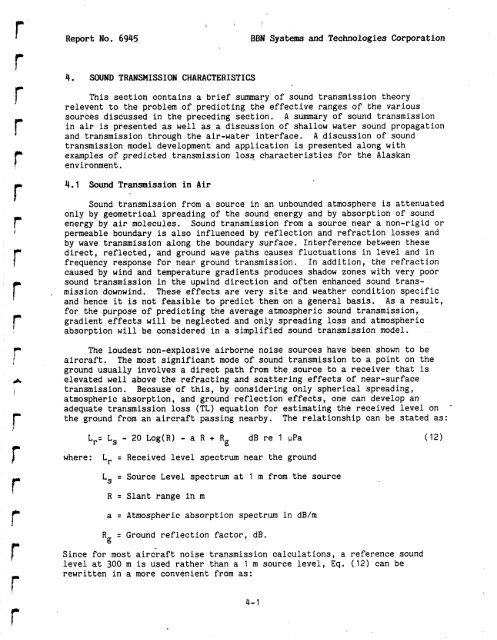Analysis and Ranking of the Acoustic Disturbance Potential of ...
Analysis and Ranking of the Acoustic Disturbance Potential of ...
Analysis and Ranking of the Acoustic Disturbance Potential of ...
Create successful ePaper yourself
Turn your PDF publications into a flip-book with our unique Google optimized e-Paper software.
Report No. 6945<br />
BBN Systems <strong>and</strong> Technologies Corporation<br />
4. SOUND TRANSMISSION CHARACTERISTICS<br />
This section contains a brief summary <strong>of</strong> sound transmission <strong>the</strong>ory<br />
relevent to <strong>the</strong> problem <strong>of</strong> predicting <strong>the</strong> effective ranges <strong>of</strong> <strong>the</strong> various<br />
sources discussed in <strong>the</strong> preceding section. A summary <strong>of</strong> sound transmission<br />
in air is presented as well as a discussion <strong>of</strong> shallow water sound propagation<br />
<strong>and</strong> transmission through <strong>the</strong> air-water interface. A discussion <strong>of</strong> sound<br />
transmission model development <strong>and</strong> application is presented along with<br />
examples <strong>of</strong> predicted transmission loss characteristics for <strong>the</strong> Alaskan<br />
environment.<br />
4.1 Sound Transmission in Air<br />
Sound transmission from a source in an unbounded atmosphere is attenuated<br />
only by geometrical spreading <strong>of</strong> <strong>the</strong> sound energy <strong>and</strong> by absorption <strong>of</strong> sound<br />
energy by air molecules. Sound transmission from a source near a non-rigid or<br />
permeable boundary is also influenced by reflection <strong>and</strong> refraction losses <strong>and</strong><br />
by wave transmission along <strong>the</strong> boundary surface. Interference between <strong>the</strong>se<br />
direct, reflected, <strong>and</strong> ground wave paths causes fluctuations in level <strong>and</strong> in<br />
frequency response for near ground transmission. In addition, <strong>the</strong> refraction<br />
caused by wind <strong>and</strong> temperature gradients produces shadow zones with very poor<br />
sound transmission in <strong>the</strong> upwind direction <strong>and</strong> <strong>of</strong>ten enhanced sound transmission<br />
downwind. These effects are very site <strong>and</strong> wea<strong>the</strong>r condition specific<br />
<strong>and</strong> hence it is not feasible to predict <strong>the</strong>m on a general basis. As a result,<br />
for <strong>the</strong> purpose <strong>of</strong> predicting <strong>the</strong> average atmospheric sound transmission,<br />
gradient effects will be neglected <strong>and</strong> only spreading loss <strong>and</strong> atmospheric<br />
absorption will be considered in a simplified sound transmission model.<br />
The loudest non-explosive airborne noise sources have been shown to be<br />
aircraft. The most significant mode <strong>of</strong> sound transmission to a point on <strong>the</strong><br />
ground usually involves a direct path from <strong>the</strong> source to a receiver that is<br />
elevated well above <strong>the</strong> refracting <strong>and</strong> scattering effects <strong>of</strong> near-surface<br />
transmission. Because <strong>of</strong> this, by considering only spherical spreading,<br />
atmospheric absorption, <strong>and</strong> ground reflection effects, one can develop an<br />
adequate transmission loss (TL) equation for estimating <strong>the</strong> received level on .<br />
<strong>the</strong> ground from an aircraft passing nearby. The relationship can be stated as:<br />
where: Lr = Received level spectrum near <strong>the</strong> ground<br />
L, = Source Level spectrum at 1 m from <strong>the</strong> source<br />
R = Slant range in m<br />
a = Atmospheric absorption spectrum in dB/m<br />
= Ground reflection factor, dB.<br />
R€3<br />
Since for most aircraft noise transmission calculations, a reference sound<br />
level at 300 m is used ra<strong>the</strong>r than a 1 m source level, Eq. ( 12) can be<br />
rewritten in a more convenient from as:
















